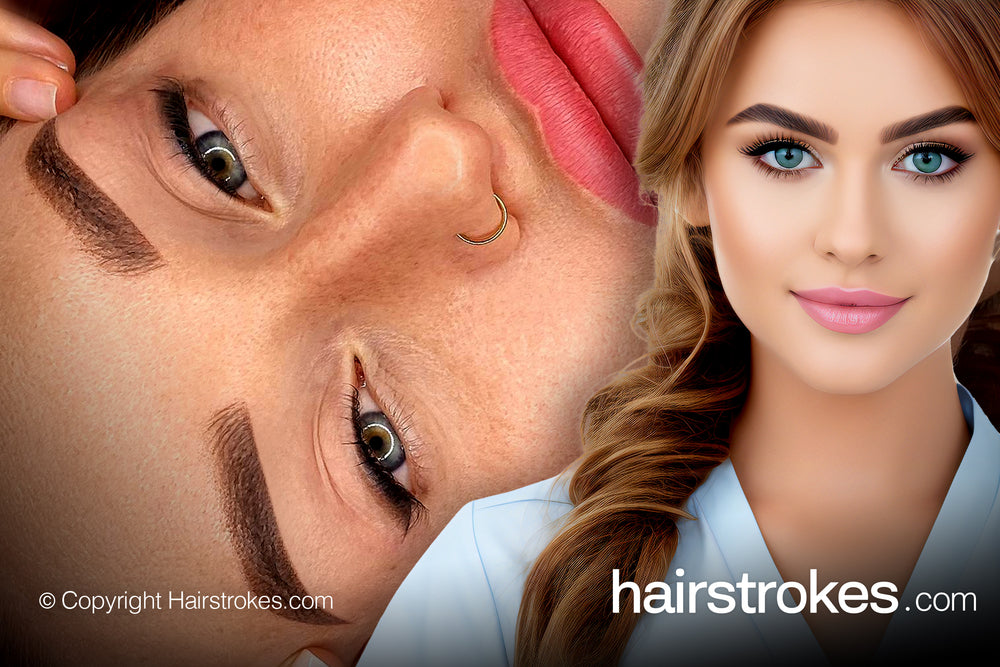6. Creating Hairstrokes
Selecting the Right Pigment
Experienced artists often recommend using organic pigments for hairstrokes due to their reduced risk of blurring and superior results. For less experienced artists, mineral pigments are advisable. Even if the rest of the brow utilizes inorganic or hybrid pigments, many prefer organic pigments for hairstrokes. Regardless of the type, testing new pigments on the skin is vital to observe healing stages rather than relying solely on product labels.
Choosing the Appropriate Needle Size
While beginners might gravitate towards ultra-thin needles (0.18 or 0.20), seasoned artists often prefer a 1RL needle with a 0.25 thickness. This size balances creating clean lines and ensuring they remain visible after healing.
When it comes to creating hair strokes, one always has to consider skin penetrability. That is not solely dependent on the thickness of the skin, however, thicker skind does often have an epridermis with harder uppermost layer (stratum corneum). The tougher the epidermis is to penetrate, the larger the needle should be. Thus, in cases of harder and thicker skin, many artists suggest using the 1 RL 0.30 or even 1 RL 0.35 needle. One should always remember that the thickness of the hair stroke lines is not solely dependent on the needle diameter as it combines multiple factors, the technique being the most important of those.
Toughness and Slight Bending of the Needle
In the pursuit of crafting natural-looking hairstrokes, the stiffness of the needle plays a crucial role. Many artists prefer using cartridges with built-in tiny support bars. These bars help stabilize the needle's movement and prevent bending during the procedure.
An additional technique some artists employ is gently pressing the needle against a gloved finger, inducing a minimal bend. This subtle adjustment can significantly reduce vibration during the application, leading to steadier and crisper lines in hairstrokes.
Benefits of a Slightly Bent Needle
The slight bend in the needle can be a game-changer, especially for artists striving for precision and refinement in their hairstroke techniques. This small modification aids in achieving a higher level of control and consistency in the strokes, ultimately enhancing the overall quality of the brow work.
Sequence of Application
It's recommended to create hairstrokes before powdering. This sequence reduces risks and usually results in better healing outcomes. After outlining the brows, add the hairstrokes to the brow heads first, followed by powdering.
Avoiding Overcrowded Patterns
Beginners should avoid densely packed hair strokes, which can lead to blurry lines upon healing. It's better to add extra lines during a retouch session, about 6-8 weeks post-procedure, allowing time to assess how the pigment settles in the skin.
Natural Asymmetry Over “Exact Mirror Image”
Contrary to some training that suggests striving for mirrored patterns, experienced artists recognize and embrace the natural differences between brows. They understand that each brow is unique, similar to fingerprints. This means focusing on achieving natural-looking patterns rather than exact symmetry.
Accounting for Powdering Intensity
When combining hairstrokes with powdering, remember that powdering adds intensity to the strokes. Artists should start with hairstrokes one shade lighter than the target shade. The subsequent application of a light powder layer is often sufficient, and additional darkening is unnecessary. This approach prevents the strokes from becoming too dark or spreading.



